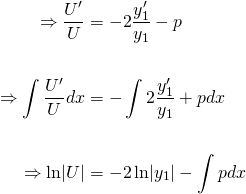Finding a Basis for solutions of Second Order ODE's
In the last post, said I would show you how solutions of second-order linear, differential equations behave physically. But before we can do that, I have to cover this rather dry, math intense proof, in order to make sense of one of the 3 possible solutions. We'll discuss these possibilities in the next post, so I apologise for that...
Now in the last post, we found that sin(x) and cos(x) are linearly independent functions that satisfy the second order differential equation...

And hence the general solution to equation (1) is a linear combination of both of these functions. So we say that sin(x) and cos(x) form the basis of solutions for equation (2) on the interval (-∞, ∞).
The general solution to (1) is...

Reduction of order and finding a Basis if 1 solution is known...
The standard form of second-order Ordinary Differential Equations (ODE's) is shown in equation (2) below...

Like above with equation (1), we expect to find 2 linearly independent solutions for equation (2) in order to form a basis for the general solution.
Now let's assume we know one solution  and want to find the other linearly independent solution...
and want to find the other linearly independent solution...
To do this, we let...

then...

Substituting these derivatives into equation (2), we get...

Ok. Since  is a solution to (2), the term in the last brackets is 0. Thus...
is a solution to (2), the term in the last brackets is 0. Thus...

Now divide equation (3) by  ...
...

Therefore equation (3) has been reduced to a first order ODE for which we can separate the variables and solve by integrating both sides...

We don't need a constant of integration because we are just finding the other solution to the ODE. So exponentiating both sides...

Now, since  and
and  , it follows that...
, it follows that...

Let's see if it works...
Since we already know the basis of equation (1), let's see if all of this derivation works.
For equation (1), with  and
and  ...
...

Finally...

Therefore, we have found the other solution of sin(x). So, it goes to show that if we know a solution  to a second-order ODE, we can find the other solution
to a second-order ODE, we can find the other solution  using equation (4).
using equation (4).
Credits:
All equations in this tutorial were created with QuickLatex
First Order Differential Equations
- Introduction to Differential Equations - Part 1
- Differential Equations: Order and Linearity
- First-Order Differential Equations with Separable Variables - Example 1
- Separable Differential Equations - Example 2
- Modelling Exponential Growth of Bacteria with dy/dx = ky
- Modelling the Decay of Nuclear Medicine with dy/dx = -ky
- Exponential Decay: The mathematics behind your Camping Torch with dy/dx = -ky
- Mixing Salt & Water with Separable Differential Equations
- How Newton's Law of Cooling cools your Champagne
- The Logistic Model for Population Growth
- Predicting World Population Growth with the Logistic Model - Part 1
- Predicting World Population Growth with the Logistic Model - Part 2
- What's faster? Going up or Coming Down?
First order Non-linear Differential Equations
- There's a hole in my bucket! Let's turn it into a cool Math problem!
- The Calculus of Hot Chocolate Pouring!
- Foxes hunting Bunnies: Population Modelling with the Predator-Prey Equations
Second Order Differential Equations
- Introduction to Second Order Differential Equations
- Finding a Basis for solutions of Second Order ODE's
Please give me an Upvote and Resteem if you have found this tutorial helpful.
Please ask me a maths question by commenting below and I will try to help you in future posts.
I would really appreciate any small donation which will help me to help more math students of the world.
Tip me some DogeCoin: A4f3URZSWDoJCkWhVttbR3RjGHRSuLpaP3
Tip me at PayPal: https://paypal.me/MasterWu